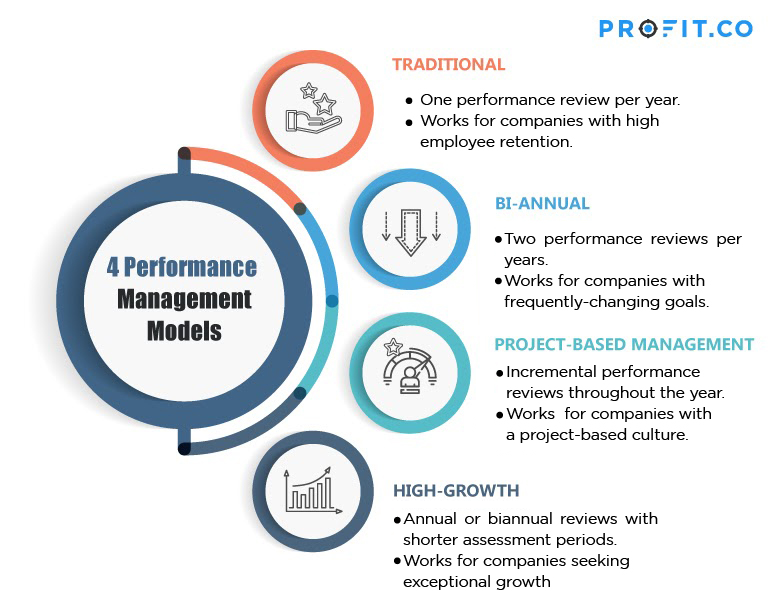Performance management models can allow for greater growth for the company by implementing cycles of planning, review, and progression to benefit management and employees.
Managing employees can already be a tricky subject, but when we have to access how employees are performing and try to target growth, a specific management model is required to accurately assess the process.
For decades now, human resources and management departments have changed their views on how to use performance management models. Older models that have seen very little success have been replaced with newer models that better assess employees.
Once these management models have been fine-tuned to better fit the company’s development and goals, human resource directors can see an increase in their employees’ drive for success and higher retention rates overall. However, these models can be a little complicated to navigate, so here’s a thorough guide to high growth performance management model practices and how you can implement them.
The Importance of High Growth Performance Management Model
Looking for perfection is the only way to motivate yourself.
High growth performance management is a cycle of several parts that allow managers to set goals, evaluate, and review employees periodically to help their employees meet company goals and personal achievements.
These management models are necessary as they help management keep up to date on how their employees are working; if employees are meeting their quotas, or if they are excelling at certain areas while failing to meet other standards.
Newer management models focus on employee’s personal development through a shorter-span cycle. Whereas older models would introduce a grand goal for the overall years, newer models create smaller goals for individual employees to meet. This shorter-term cycle allows management to better evaluate how these employees are functioning to their strengths and weaknesses.
In addition, to provide higher growth opportunities, these newer management models create steps and personal achievements that employees can work towards. This allows management to specifically tackle certain issues that the employee might be having, or perhaps better focus their developed abilities towards a greater goal. This allows the employee to grow, feel like their work is valued and worthwhile, and better focus on how they should do their job.
Overview of Management Models

Management models vary widely in how they are implemented, but we’ll cover the basic four management models to give you a rough overview of how they function.
Traditional Management Model
This model is well known as many companies have been implementing it for decades now. The general focus is setting an annual date of performance review and assessment for each employee. Management would set a goal for these employees to achieve for the year, perhaps divide this up into sections to achieve, and then wait out the year to assess their growth.
This model relies on high employee retention to have the employee last the year to be assessed. If your company has high retention, this can be a good option. However, if increasing employee retention rates is a goal, it would be best to focus on a growth management model that has shorter-term growth goals that we’ll describe later.
Bi-Annual Management Model
This model divides the traditional management model into two sections throughout the year. Every six months or bi-annually, management would give evaluations to their employees and the employees would give their evaluations for half of a year of work.
This model allows managers to better focus their efforts on employee growth with shorter-term evaluations. This model is great if a company is developing or growing quickly as thorough evaluations on a bi-annual level can better detail employee goals and achievements. It also allows employers to reward employees every six months to keep them motivated to grow.
This model introduces the issue of these bi-annual meetings being troublesome and time-consuming for both management and employees. If a company is growing and their goals are always shifting, this issue can be outweighed. However, if the company is stable, the issue can develop into consuming too much time and effort in the long run.
Project-Based Management Model
This model tackles evaluation and goal setting on a project-by-project basis instead of set in timely goals. At the start of a project, the goals and rewards are introduced to the employees, and by the end of the project, the employees are evaluated for how they performed.
This model is a specific model that can be used when your company structures its work on projects where employees and the company can grow from. It’s up to management to determine if shorter projects should be evaluated, or longer projects to be broken up into shorter cycles for evaluation.
New High Growth Management Model
This is a hybrid model that’s becoming more popular. It focuses on annual or bi-annual evaluations with smaller periodic assessment periods to allow management to clarify goals, and employees to be reminded and refreshed on what goals they should be aiming for.
The greatest strength of this model is the variable nature of growth it presents. Management can choose to conduct full evaluations on long intervals and provide shorter goals for their employees to feel more motivated to achieve. Shorter monitoring periods of assessment can be scheduled to lightly report and evaluate employees between longer intervals.
Stages of a High Growth Performance Management Model
No matter what management model you choose for your business, you can implement a more refined process to better account for how your model operates.
This high growth performance management cycle plan has four main sections to follow. Please note, these four sections can be performed at any time, not just in a perfectly flowing cycle.
Planning
Before implementing any stage into your management model, planning what your managers and employees should be accomplishing is vital to success. The model relies entirely on this stage, but this plan can be changed later on if situations and circumstances change.
Setting Goals
From the very start, set concrete goals for your team to achieve. Goals give everyone from management to employees tangible achievement to aim for, motivating them to work harder and achieve personal growth that transfers into growth for the company.
Once you’ve figured this out, one great method of structuring goals was created by George T. Doran called SMART which employs an acronym to define each vital part of the goal for the sake of clarity.
SMART Method
When you set goals that help create a system to track and measure progress, which helps promote employee and organizational success, they are referred to as SMART goals:
- Specific – The description of the goal is clear and defined with details of how the goal can be achieved through the employee’s action. This description should also include the quality of the work and why this goal is important to achieve.
- Measurable – This is where you set a method of being able to continually measure how the goal is met. For example, if you want to boost sales of a product, you would list the number of units sold as a goal.
- Achievable – This is where you take into account your team or employee and evaluate an achievable goal for the circumstances. The goal should be enough for the employee to achieve if they work hard, but not unattainable by any means. Employees should feel they can achieve this goal if they try hard.
- Relevant – This goal should resonate with the employee’s training and job and the overall targets for the company.
- Time-Bound – The timeline with an end date that should define when the goal should be met. It should be achievable, and if possible broken down into smaller time-focused steps to keep on track.
Monitoring
For a high growth management model, it’s important to monitor the progress of your employees and management working towards the company goals. How you wish to implement this monitoring step can vary and depend on the dynamics of your goals and your company.
Monitoring entails focusing on how employees are operating towards their timely goals with accurate measurement of their performed duties. It’s important to understand that with long-term management models like the traditional annual or bi-annual model, the monitoring stage can feel rigid as meetings are few and far between.
If goals are improperly set, and there are no meetings to assess or change these goals, these goals can create issues. Goals that are set for a long period of time can seem unachievable due to the large measurement of achievement, which can demotivate employees. If the measurement for this goal is too low, employees won’t feel motivated to achieve a greater goal.
You can alleviate these issues by holding meetings where you assess and reevaluate your goals. During these meetings, you can present the current level of achievement following your timeline and ask for employee input. When employees can give their opinion on their performance and offer suggestions to better achieve the goal, they feel more motivated as their opinions are valued. This will motivate them to grow and raise retention rates within the company.
If goals require a long period of time, it’s wise to set smaller intermediate goals that employees can achieve, and during these meetings, you can evaluate if these short-term goals have been met.
If you have overall short-term goals or long-term goals broken into shorter sections, it’s important to schedule periodic meetings to assess and present how your employees are meeting their goals. With monthly or quarterly meetings, management can better communicate and receive input for how the goals are being achieved.
Reviewing
At the end of the goal’s set time period, conduct an employee performance review.
It’s important to allow the employee to first conduct a self-assessment for their performance while you write up your assessment. These two assessments can give you insight on where the employee feels they aren’t growing or where they think they’ve grown during the period.
When you evaluate your employee, try to use the notes you’ve taken during the small-term monitoring periods to compile their overall achievement. Sometimes certain periods of time the employee might have been more or less motivated. If you assess them purely on their end-of-term assessment, you might not be able to fully understand how they’ve performed from start to finish.
Performance review questions should be written in a positive tone. For example:
- Did they achieve their goal?
- Was the goal realistic to them? If so, was it easily achievable? If not, was the goal set too high?
- Did you see notable growth in the employee?
- What strengths did the employees show in their achievement?
- What did the company do to help the employee achieve their goal?
You can also use this time to evaluate your current management model. Perhaps it needs some alteration to best suit the company’s goals. Or perhaps it works well, but the implementation of one or more aspects needs refining.
Rewarding
Rewards are vital for keeping employees motivated. They should be presented as a reward when the goal is set, or at least inferred as the employees would understand what rewards they can acquire when they achieve their goals.
All rewards should be merit-based for the reward to feel valued for those who worked hard, and not for those who underperformed to meet the set standard. Determination for these rewards should be given from the employee’s overall performance from the start to finish of the goal. Employees should feel motivated to work hard to achieve the goal set and continue working hard after it’s achieved.
Example of some rewards you can offer:
- Promotion
- Pay raise
- Special or advanced projects
- Positive review or evaluation that can lead to a promotion or pay raise
- Public company acknowledgment.
- Additional time-off or days off
Building the Model
If these steps are taken to heart and implemented, your management model can evolve and you can see the company and employee growth develop towards your goals.
You most likely use many of these methods already. There are many ways you can tweak your current management model, from creating more review periods to detailing motoring periods to focus better on individual employees. With a few small tweaks to your model, you can see company growth, raise employee retention rates, and allow the company to operate to higher levels of success with skilled and goal-oriented employees.
Profit.co’s Performance Management
Profit.co’s performance management module allows HR administrators and managers to conduct customizable, detailed, and efficient performance reviews that can adapt to any method of performance management system a company chooses.
Performance reviews can be implemented as frequently or infrequently as needed, and customized to adapt to various departments, positions, and even specific projects.
OKRs, the renowned goal-setting methodology that has helped companies of all sizes and in all industries execute their strategy, are the central factor in all of Profit.co’s modules.
With the performance management module, reviews can be conducted alongside a progress report of all OKRs that an individual employee is involved in. This helps evaluate a team member’s scope of responsibility as well as how they are prioritizing their work and their various projects. While OKR progress should not be directly quantified into a performance review rating, they can be helpful in determining if an employee has stuck to their priorities they set at the beginning of the quarter, and how they are impacting the overall progress of the company.
Profit.co performance management– alongside the other intuitive business management tools— can help support a high-growth company and an agile team.

